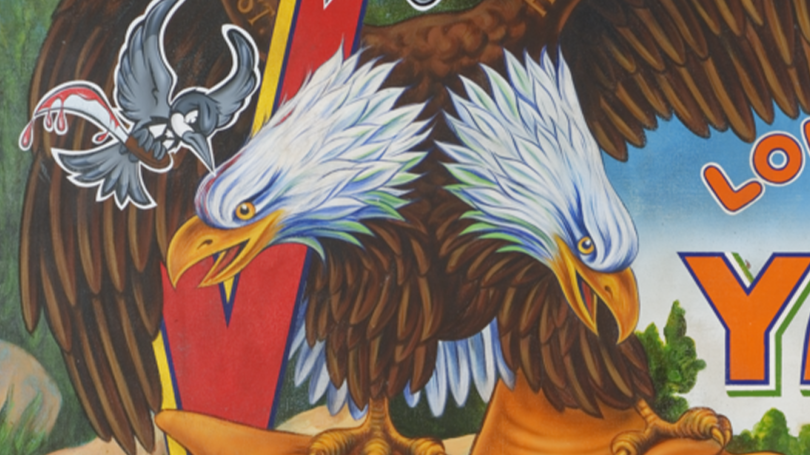AMELIA KAHL, Barbara C. and Harvey P. Hood 1918 Senior Curator of Academic Programming
Miguel Luciano's work often uses historical objects and artifacts to explore different facets of Puerto Rican culture both on the island and in diasporic Puerto Rican communities like New York, where he currently resides. This large-scale painting uses imagery from an early-20th-century postcard advertising "Victory" brand yams as the basis for a critique of U.S. policy. It is part of the "Louisiana Porto Ricans" series of paintings based on yam and sweet potato labels from the 1930s and 1940s that featured some of the earliest visual representations of Puerto Ricans in the United States. Many Puerto Ricans recruited to work in Hawaii's sugar and pineapple plantations in the early 20th century came through Louisiana as their first U.S. port of entry. The "Porto Rican Yam" in the painting is a variety originally imported from Puerto Rico that Louisiana farmers were planting heavily in the 1940s.
In this work, Luciano has changed "Victory" to "Vulture," transforming a patriotic bald eagle into a twin-headed monster whose wings are labeled with the predatory institutions of "Wall St." and "Hedge Funds," referring to Puerto Rico's debt crisis and the U.S. institutions that have manipulated it. It holds the Porto Rican yams (and the metaphorical island territory) in its talons. Meanwhile, one of the yams transforms into a Cemí, an important spiritual symbol among the Taíno, the indigenous people of Puerto Rico and the Caribbean. Trigonolitos (three-pointed Cemí forms) often evoke the shape of the yam, an indigenous food crop in the Caribbean. Flying out of the mouth of the Cemi are three pitirres, small birds indigenous to Puerto Rico that are known to aggressively defend their territory against larger birds of prey. With the Puerto Rican flag rendered in black and white on their chests, they are rebellious symbols of Puerto Rican resistance who use a machete (another important cultural symbol) to draw blood from the eagle.
Luciano painted this work in response to the 2016 PROMESA legislation (the Puerto Rico Oversight Management and Economic Stability Act), which established a U.S.-appointed, unelected fiscal control board in the face of Puerto Rico's severe debts. Promoted as an economic relief bill, the act significantly reduced Puerto Rico's control over its own economy while imposing crippling austerity measures. The painting's text at the lower right corner reading "Packed by Noah Lajunta, Carencro, LA." Is a play on words that can be read as No a la junta, a rallying cry against PROMESA and the fiscal board. Ironically, the town of Carencro, Louisiana, from the original label is named for the Cajun words for buzzard, translating to "carrion crow." Large flocks of American black vultures once roosted there. Luciano also alters "50 lbs. net when packed" to "50 sts. net when packed," alluding to Puerto Rico's complicated and often contested status as a U.S. colony.
This painting was created in 2017 at the 100-year mark of the Jones Act, which gave U.S. citizenship to Puerto Ricans. It was also the year that Hurricane Maria devastated Puerto Rico, amplifying the island's economic struggles and the predatory projects of disaster capitalism in the wake of the hurricane.
Click here to view this object's catalogue entry.


